#Imperial Indian Palace
Note
I know you don't usually do these kinds of posts, but you're probably one of the most implicated in black history month people that I follow so I wanted to ask you, as I already value your opinions in Acotar, what do you think of the documentary where actual historians claim Cleopatra was a black woman? Lately, this has been a pretty active topic on my fyp on TikTok, and I wanted to know a black woman's perspective on this.
Thank you in advance, and if you usually don't answer these questions or don't want to answer this one, I'll totally understand, and there's no problem at all.
I didn’t know there was a new documentary out, but when I saw the name Cleopatra I automatically sighed because I knew what was coming. This is a subject a know a little 🤏🏾 about, actually, because I researched it a bit myself in my last year of high school (and stopped because of the uh. NASTINESS associated with this particular subject) and though it’s been a few years I remembered some main, basic things, and I wanted to check a few things first.
At best, in the most CHARITABLE interpretation as far as I in my limited knowledge can tell, it would be correct to say that’s it’s POSSIBLE that she MAY have been mixed Black because, though she was part of the GREEK Ptolemaic dynasty that ruled Egypt (Ptolemy being one of Alexander the Great’s generals who got the Egyptian portion of his empire after Alexander died), that’s on her fathers side; her mother’s exact ethnicity isn’t known. Not that this won’t stop the hoteps from running off and claiming her and all of ancient Egypt as Black though So some have ***speculated*** that her mother—and thus Cleopatra—may have potentially been part Egyptian (and that goes into the issue of deciding that the “Egyptian” in this instance had to have been Black rather than MENA but that’s again a whole other can of worms). BUT it’s more likely that her mother was Greek due to the uh, PRACTICE™️ of inbreeding and it not being common for the dynasty to marry Egyptians. So it’s more probable that she was fully Greek/Macedonian and not part Egyptian, much less part Black. (Also some historians speculate she may have had Persian blood? I guess? Again it’s a can of worms, not something i’m digging deep into because of the nastiness that you often stumble across) Unless there’s a new study confirming her mother’s identity or something that I missed, it’s simply incorrect to claim that Cleopatra was undeniably Black, because though it is ***possible*** she most likely ***wasn’t.***
But this topic really upsets me, because there are LEGITIMATE Black kingdoms and empires who were mighty and well developed and powerful like the Aksumite empire and kingdoms of Kongo and Loango and the Great Zimbabwe empire and the empires of Ghana and Mali and Songhay and the Ashanti kingdom and the WHOLE SWAHILI COAST THAT WAS INVOLVED IN THE INDIAN OCEAN TRADE ROUTE and they had their own great rulers, their own kings and queens and emperors and empresses, their palaces and castles, their own cities and towns, their own complex civilizations and dynastic royal families that deserve the attention Cleopatra and ancient Egypt get. They were erased—and Egypt was not—by white people to prop themselves up as the only race capable of forming civilizations and advanced societies as a means of justifying colonization and imperialism to “civilize” the rest of the world and as a result many of those other empires have been erased from our education system here in the states and many people cling to ancient Egypt as proof that we’re not inferior and aren’t savages like white people claim due to believing that since Egypt’s in Africa it had to have been mostly Black when Egypt, and the Ptolemaic dynasty and Cleopatra in PARTICULAR, are literally the worst example that could’ve been chosen and were the only African kingdom spared erasure FOR A REASON.
Anyway, I don’t like it, it’s disingenuous and does US wrong because we need to give that energy to other African kingdoms that need and could use the fame Egypt + Cleopatra get, and we deserve a better education system to teach us this stuff. I hope this answers your question? And I don’t mind any kinds of asks 🥰
#I get the desire to claim Egypt because I remember in high school a racist white guy asked why Africans didn’t build their own civilizations#And that’s what sent me researching in the first place so I truly get the frustration but black women we can do BETTER#ask#anon#cleopatra#egypt#africa#racism#Don’t come at me in my inbox yall#antiblackness
1K notes
·
View notes
Text
A walk through Bengal's architecture
Bengali architecture has a long and rich history, fusing indigenous elements from the Indian subcontinent with influences from other areas of the world. Present-day Bengal architecture includes the nation of Bangladesh as well as the Indian states of West Bengal, Tripura, and Assam's Barak Valley. West Bengal’s architecture is an amalgamation of ancient urban architecture, religious architecture, rural vernacular architecture, colonial townhouses and country houses, and modern urban styles. Bengal architecture is the architecture of Wind, Water, and Clay. The Pala Empire (750–1120), which was founded in Bengal and was the final Buddhist imperial force on the Indian subcontinent, saw the apex of ancient Bengali architecture. The majority of donations went to Buddhist stupas, temples, and viharas. Southeast Asian and Tibetan architecture was influenced by Pala architecture. The Grand Vihara of Somapura, which is now a UNESCO World Heritage Site, was the most well-known structure erected by the Pala rulers.

The Grand Vihara of Somapura
According to historians, the builders of Angkor Wat in Cambodia may have taken inspiration from Somapura. Bengal architecture became known for its use of terracotta due to the scarcity of stone in the area. Clay from the Bengal Delta was used to make bricks.
The temple architecture has distinct features like the rich wall decoration, often known as the terracotta temples, which was one of the remarkable elements of Bengali temple architecture. The double-roofed architecture of thatched huts was replicated by Bengali temples. Square platforms were used to construct the temples. Burnt brick panels with figures in geometric patterns or substantial sculptural compositions served as the temples' adornment.

Dochala style
These served as models for many temples that were built in undivided Bengal. Construction materials used in ancient times included wood and bamboo. Bengal has alluvial soil, so there isn't a lot of stone there. The bricks that were utilized to build the architectural components were made from stone, wood, black salt, and granite. Bengal has two different types of temples: the Rekha type, which is smooth or ridged curvilinear, and the Bhadra form, which has horizontal tiers that gradually get smaller and is made up of the amalaka sila. Mughal architecture, including forts, havelis, gardens, caravanserais, hammams, and fountains, spread throughout the area during the Mughal era in Bengal. Mosques built by the Mughals in Bengal also took on a distinctive regional look. The two major centers of Mughal architecture were Dhaka and Murshidabad. The do-chala roof custom from North India was imitated by the Mughals.

Jorasako thakurbari
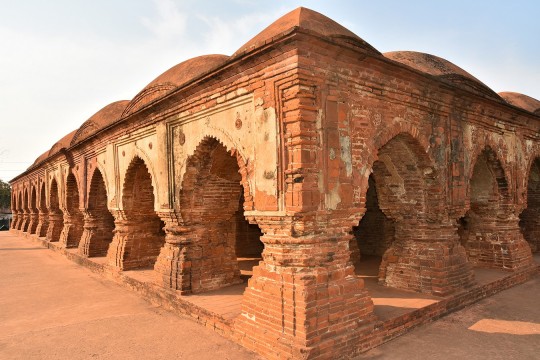
The Rasmancha is a heritage building located at Bishnupur, Bankura district, West Bengal.
Influence of the world on Bengal architecture: Although the Indo-Saracenic architectural style predominated in the area, Neo-Classical buildings from Europe were also present, particularly in or close to trading centers. While the majority of country estates had a stately country house, Calcutta, Dacca, Panam, and Chittagong all had extensive 19th and early 20th-century urban architecture that was equivalent to that of London, Sydney, or other British Empire towns. Calcutta experienced the onset of art deco in the 1930s. Indo-Saracenic architecture can be seen in Ahsan Manzil and Curzon Hall in Dhaka, Chittagong Court Building in Chittagong, and Hazarduari Palace in Murshidabad.
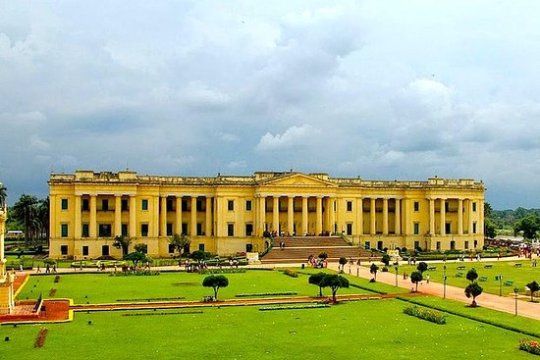
Hazarduari Palace in Murshidabad
The Victoria Memorial in Kolkata, designed by Vincent Esch also has Indo-Saracenic features, possibly inspired by the Taj Mahal. Additionally, Kolkata's bungalows, which are being demolished to make way for high-rise structures, have elements of art deco. The 1950s in Chittagong saw a continuation of Art Deco influences. The Bengali modernist movement, spearheaded by Muzharul Islam, was centered in East Pakistan. In the 1960s, many well-known international architects, such as Louis Kahn, Richard Neutra, Stanley Tigerman, Paul Rudolph, Robert Boughey, and Konstantinos Doxiadis, worked in the area.

The Jatiyo Sangshad Bhaban
This iconic piece of contemporary Bangladeshi architecture, was created by Louis Kahn. Midsized skyscrapers dominate the cityscapes of contemporary Bengali cities, which are frequently referred to as "concrete jungles." With well-known architects like Rafiq Azam, architecture services play a key role in the urban economies of the area. Overall Bengal architecture was influenced by various contemporaries of their time and continues to evolve.

Gothic architectural style seen in St. Paul's Cathedral in Kolkata.

Zamindar era buildings in ruin.

Belur Math in Howrah
#bengali#bangla#west bengal#bangladesh#tripura#assam#desi#বাংলা#india#architecture#tales#bengal architecture#history#kolkata#international#technology#information#temple#asia#bricks
176 notes
·
View notes
Text
India archive reveals extent of ‘colonial loot’ in royal jewellery collection
File from India Office archive details how priceless items were extracted from colony as trophies of conquest
by David Pegg and Manisha Ganguly
Published: 14:00 Thursday, 06 April 2023
Five years ago, Buckingham Palace marked its summer opening with an exhibition celebrating the then Prince Charles’s 70th birthday with a display of his favourite pieces from the royal collection, Britain’s official trove of items connected to the monarchy. “The prince had a very, very strong hand in the selection,” the senior curator said.
Among the sculptures, paintings and other exhibits was a long gold girdle inlaid with 19 large emeralds once used by an Indian maharajah to decorate his horses. It was a curious choice to put into the exhibition in light of the violent means by which it had come into the hands of the royal family.

Emerald girdle of Maharaja Sher Singh, c 1840. Photograph: Royal Collection Trust / © His Majesty King Charles III 2023
As part of its Cost of the crown series, the Guardian has uncovered a remarkable 46-page file in the archives of the India Office, the government department that was responsible for Britain’s rule over the Indian subcontinent. It details an investigation, apparently commissioned by Queen Mary, the grandmother of Elizabeth II, into the imperial origins of her jewels.
The report, from 1912, explains how priceless pieces, including Charles’s emerald belt, were extracted from India as trophies of conquest and later given to Queen Victoria. The items described are now owned by the monarch as property of the British crown.
Plundered stones
To fully understand the context behind the jewels, and their place in India’s history, it was necessary to visit the archives.
A journal records a tour in 1837 of the Punjab area in north India by the society diarist Fanny Eden and her brother George, the governor general of the British Raj at the time. They visited Ranjit Singh, the maharajah in Lahore, who had signed a “treaty of friendship” with the British six years earlier.
The half-blind Singh wore few if any precious stones, Eden wrote in her journal, but his entourage was positively drowning in them. So plentiful were the maharajah’s gems that “he puts his very finest jewels on his horses, and the splendour of their harness and housings surpasses anything you can imagine,” she wrote. Eden later confided in her journal: “If ever we are allowed to plunder this kingdom, I shall go straight to their stables.”
Twelve years later, Singh’s youngest son and heir, Duleep, was forced to sign over the Punjab to the conquering forces of the British East India Company. As part of the conquest, the company did indeed plunder the horses’ emeralds, as well as Singh’s most precious stone, the legendary Koh-i-noor diamond.
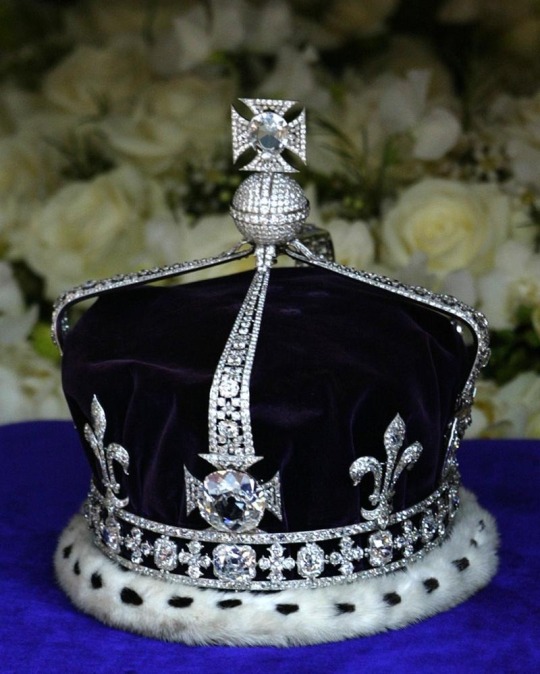
The queen mother’s crown sits on top of the coffin during her funeral in 2002. Photograph: Dan Chung/The Guardian
Today, the Koh-i-noor sits in the crown of Queen Elizabeth the Queen Mother, on display at the Tower of London, and it has become an emblem of Britain’s tortured relationship with its imperial history.
Anita Anand, a journalist and historian who co-wrote a book titled Koh-i-noor on the diamond, said it was “a beautiful and cold reminder of British supremacy during the Raj”, the period between 1858 and 1947 when India was ruled by the crown.
“Its facets reflect the fate of a boy king who was separated from his mother,” Anand said. The stone too was “taken far away from his home, recut and diminished”. Anand said: “That is not how India sees itself today.”
Buckingham Palace is plainly aware of the sensitivities surrounding looted artefacts. After the Indian government let it be known that for Camilla, the Queen Consort, to wear the Koh-i-noor at Charles’s coronation would elicit “painful memories of the colonial past”, the palace announced she would swap it for a less contentious diamond.
But, as was discovered by Queen Mary, the Koh-i-noor was not the only gem taken from Singh’s treasury to have found its way to the British monarchy.
Royal with a pearl necklace
Among the jewels identified in the document found by the Guardian is a “short necklace of four very large spinel rubies”, the largest of which is a 325.5-carat spinel that later came to be identified as the Timur ruby.
Its famous name is erroneous: research by the academic Susan Stronge in 1996 concluded it was probably never owned by Timur, a Mongol conquerer. And it is a spinel, a red stone similar to, but chemically distinct from, a ruby.
Elizabeth II was shown handling it in the 1969 BBC documentary Royal Family, and was clearly acquainted with the myths surrounding it. “The history, of course, is very fascinating. It belonged to so many kings of Persia and Mughal emperors, until Queen Victoria was sent it from India,” she observed.
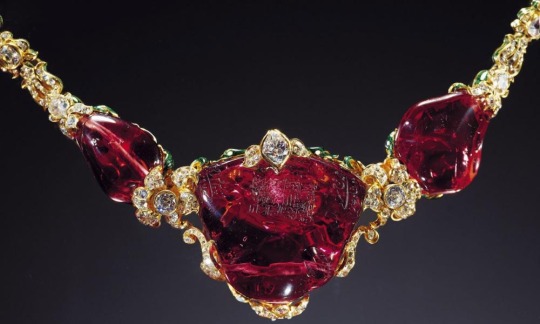
The Timur ruby necklace, 1853. Photograph: Royal Collection Trust / © His Majesty King Charles III 2023
The queen was never pictured wearing the item. However, she may have worn another of the Lahore treasures, identified in the India Office report as “a pearl necklace consisting of 224 large pearls”.
In her 1987 study of royal jewellery, Leslie Field described “one of the Queen Mother’s most impressive two-row pearl necklaces … made from 222 pearls with a clasp of two magnificent rubies surrounded by diamonds that had originally belonged to the ruler of the Punjab” – almost certainly a reference to the same necklace.

The queen wearing pearls at the Royal Opera House in 2012. Photograph: AFP/Getty Images
In 2012, Elizabeth II attended a gala festival at the Royal Opera House in London to celebrate her diamond jubilee. Photographs showed her wearing a multi-string pearl necklace with a ruby clasp.
Were these Ranjit Singh’s pearls? There was speculation they may have been, though Buckingham Palace was unable to confirm either way.
Queen Mary’s interest appears to have been prompted by curiosity about the origin of some of her pearls rather than any moral concern about the manner in which they were obtained. But a Buckingham Palace spokesperson said slavery and colonialism were matters that “his Majesty takes profoundly seriously”.
Shashi Tharoor, formerly an undersecretary at the United Nations, and currently an MP in India, said: “We have finally entered an era where colonial loot and pillage is being recognised for what it really was, rather than being dressed up as the incidental spoils of some noble ‘civilising mission’.
“As we are seeing increasingly, the return of stolen property is always a good thing. Generations to come will wonder why it took civilised nations so long to do the right thing.”
#abolish the monarchy#queen elizabeth ll#king charles the cruel#brf#colonialism#koh i noor#cost of the crown#the guardian#british royal family#imperialism
74 notes
·
View notes
Note
Hi! I hadn't the opportunity to read during Christmas, but I am catching up, and I hope you won't mind if I send some questions on the way. In the hunter's house, Tripitaka eats rice mixed with millet (or sorghum?) and Indian corn, which is a form of maize according to Wikipedia. I know sweet potato became a staple crop in the early Qing dynasty, but I was impressed at maize showing up this early! Might Wu mean another grain?
I agree that the descriptions of the landscape were very nice :^) Mo Yan writes similarly about the village in which his novel Red Sorghum takes place. You can really sense the tender fondness of the author in such cases!
This is what I found about maize:
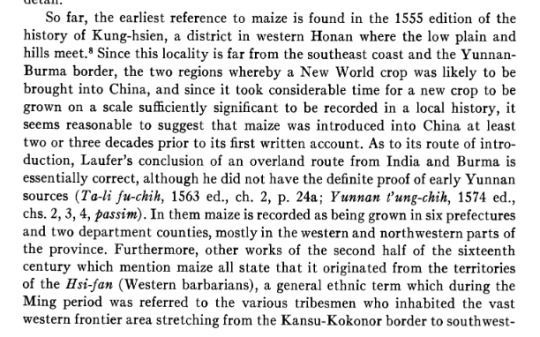
From this paper.
The thing is... The story is set in the Tang Dynasty, and the author was alive when it was first introduced, so he must have known that it was a foreign grain...
However, I found this other paper just know as I was writing the previous paragraph. I'm going to copy the findings under the cut:
In the Chinese herbal book Bencao pinhui jingyao (or formerly spelled as Pents'ao p'inhui chingyao) that was compiled and presented to the emperor Xiao Zong of the Ming Dynasty in 1505, there is a clear il- lustration of maize, Zea mays. It appears in a drawing under the caption of Yiyi-ren (Job's Tears)or Coix lachryma-jobi var. ma-yuen, or C. ma-yuen. The plant on the right is unmistakably maize. [...]
The book lay dormant, blanketed by a thick coat of dust, in the Imperial Treasure house in Beijing until the collapse of the Qing Dynasty in 1912 and was never exposed to anyone outside the Forbidden Palace. No scholarly dissertation has ever touched on the year of 1505 in which this remarkable book was compiled. Its surprising maize illustration inevitably raises the question of whether maize had existed in China before Columbus, that is, earlier than 1492. [...]
A recent study by this author suggests an even earlier date of record. There is an amazingly early mention of maize in the poem Youwu zashu, written by Xie Yingfan in Jiangnan at the very beginning of the Ming Dynasty (1368). Xie wrote, ``(yellow) gold is like yumi and like pearl.'' Here yumi can only refer to maize. Literally, yu means jade and mi means rice [...]

The paper doesn't give any explanation to what kind of corn they ate, but if Wu said specifically "indian corn", it must have been from the Americas and he commited an anachronism.
This was a very unsatisfactory research :(
17 notes
·
View notes
Note
do you know of any scholarly~ works re: concubine narratives? or re: historical (or mythic, etc.) concubines? been thinking a lot about concubine narratives lately. x_x
You bet I do.
(Usual caveat here that I use the term 'concubine' to describe a range of situations where someone is forced into an ongoing sexual relationship involving a spectrum of levels of violence and coercion. These are situations that have occurred frequently across cultures and historical periods especially in the context of war, imperialism, and slavery. I include both situations where someone is actively enslaved or otherwise taken captive in war as well as cultural circumstances in which the position of concubine to someone in power might be a respected role that gives someone access to some levels of power, even if it does not confer the same societal position as a spouse.
The term concubine itself has not great implications and associations, but I prefer it to something like 'sex slave' which I actively despise. Many of the people written about in these texts would not identify with that term and some might be insulted by it.)
On this topic, I eagerly await Kathy Gaca's forthcoming book, Rape, Enslave, or Kill: Men, Women, and the Religion of Sexual Warfare and Colonialism from Antiquity to Modernity. But, until then:
Camilla Townsend, Malintzin's Choices: An Indian Woman in the Conquest of Mexico
Leslie Pierce, Empress of the East: How a European Slave Girl Became Queen of the Ottoman Empire
Galina A. Yermolenko (ed), Roxolana in European Literature, History, and Culture
Ibn al-Sai, Consorts of the Caliphs: Women and the Court of Baghdad (trans. Shawkat M. Toorawa) [this is a very cool 13th century text]
Matthew S. Gordon and Kathryn A. Hain (eds), Concubines and Courtesans: Women and Slavery in Islamic History
Heidi J. Nast, Concubines and Power: Five Hundred Years in a Northern Nigerian Palace
Nina Kushner, Erotic Exchanges: The World of Elite Prostitution in Eighteenth-Century France
Elizabeth D. Heineman (ed), Sexual Violence in Conflict Zones: From the Ancient World to the Era of Human Rights
Gwyn Campbell and Elizabeth Elbourne (eds), Sex, Power, and Slavery
Ruth Bernard Yeazell, Harems of the Mind: Passages of Western Art and Literature [this is an analysis of western orientalist narratives]
The essay collections are more varied in quality than the single authored books in this list, but all of them have interesting material in them.
And several very strong texts on the role of sexual violence in the transatlantic slave trade:
Thavolia Glymph, Out of the House of Bondage: The Transformation of the Plantation Household
Lisa ze Winters, The Mulatta Concubine: Terror, Intimacy, Freedom, and Desire in the Black Transatlantic
Vincent Woodward, The Delectable Negro: Human Consumption and Homoeroticism within US Slave Culture
38 notes
·
View notes
Text
Known places in Magi and what they’re based on because I have no life and I’m bored as fuck
Aktia: No official basis is given for this country but Sinbad does state it’s known for it’s pearls so possibly it could be Bahrain, an island country in the Persian Gulf, which is famous for its pearling industry
Artemyra: Ancient Greece. The clothing and jewellery is the biggest giveaway but this is also a kingdom known for its warrior women, like the amazonians, and the word “Artemyra” itself probably comes from “Artemis”
Balbadd: India and the one I’ve talked about the most. Everything in Balbadd from the architecture to the attire to the trade and fishing is based on India’s culture and Balbadd in canon is noted for being a very imported trade area and for being unique in how multicultural it is
Heliohapt: Probably the most obvious of the series outside of Reim, this is Ancient Egypt. There’s absolutely no way you could mistake this for anything else they literally have a big ass pyramid with an eye of horus on it lmao
Imuchakk: While it’s never been officially stated, comparisons have been made between the Imuchakk and Shaman King’s portrayal of the Ainu, from the naming schemes to the clothing and affiliation to the cold
Kina: Ancient Japan. It’s located to the east of Kou, their current king is called Yamato Takeruhiko, who has a tattoo of an oni on his back, uses a katana, wears japanese armour etc
Kou: Imperial China! The royal family of Kou is literally called the Imperial Family, the naming schemes are all Chinese, absolutely everything about this place screams China if I tried to list everything we’d be here forever
Magnostadt: Unknown. Magnostadt’s name is a combination of latin (magnus) and german (stadt) but previously the kingdom was called Musta’sim, which is arabic. The term “goi” is also used for people who are non-magicians which is, ya know, very obviously meant to be the jewish “goy” [and yes in the actual magnostadt arc this is INCREDIBLY problematic given the villain of the arc is designed to have a big nose and warts all over his face etc but we won’t get into that] so it’s. Ehhhh kinda hard to pinpoint this one. It’s a mishmash of things
Parthevia: Ancient Persia! The name of this country comes from the persian “parthava” which means “parthian” as in “Parthian Empire.” This is where Sinbad, Ja’far and Drakon are from
Reim: Rome. This place is literally introduced as having a huge coliseum and being known for its gladiators, and their founder was Remus. Can’t get more obvious than that
Sasan: This is another weird one because while most of the citizens have Greek names [Spartos, Darius etc] the place itself is based on the Sasanian Empire, which was the longest lived persian-imperial dynasty, and the empire itself was named after the House of Sasan. I genuinely had to look this one up because I thought for sure it was straight Greece based on the names but ¯\_(ツ)_/¯
Sindria: Indian Subcontinent and various others. This place is incredibly multicultural but in short: sindria derives from the sanskrit “sindhu” which is a name for the indus river, physically the country looks like the greek island of Nisyros, the palace of Sindria is loosely based on the Süleymaniye Mosque in Turkey and they have a festival called Mahrajan after King Mahrajan, a character in Sinbad the Sailor from 1001 Nights
24 notes
·
View notes
Text


really not great photographs but I saw these depictions of Portugese Goan couples (from the forehead mark and general historical context, probably more what would come to be termed half-castes- Portugese father, Indian mother) in the Maharana of Mewars palace in Udaipur, Rajasthan a few days ago. Super interesting to think that the Mughals actually arrived in India a few decades after the Portugese did! And that initially at least, European imperialism didn't actually entail a notion of racial superiority or seperateness as it would come to do.
2 notes
·
View notes
Note
Hey genuinely wondering what you meant when you said that Vandana Shiva has "blood on her hands"
You might remember the pictures going around on tumblr a little while ago when the president's palace in Sri Lanka was stormed by angry citizens.
You know

Now part of what caused all this unrest was caused by a famine that struck the country, effecting both the economy as well as, you know, people's ability to eat.
Now this famine did not spring up out of nowhere, nor was it a natural crisis. This was caused by the country embracing and changing 100% of it's farms to organic. See, organic farming is nice and all but between having a much smaller yield, it's also much more susceptible to pests and disease. It's why it's generally a bad idea to have literally every farm in your country using methods that are over a hundred years old.
See, the president was a big big fan of Vandana Shiva, drank in every word she said, and it was quite literally due to her advice that he banned all chemical fertilizers in the country, leading to a famine by the end of the year.
Now I'm not a biologist nor am I in any agricultural-based science field. Neither is Vandana Shiva! She does have a PHD, but it is not in nuclear physics or whatever other science field she has lied about. It's in philosophy. Now I won't say that disqualifies her from speaking on the matter of farming, but her being listened OVER experts in the field is what is concerning.
I'm not even focusing on the various other lies she peddles, like calling golden rice a myth, claiming GMOs are filled with nonspecific "toxins", lying about Indian farmers committing suicide thanks to bi-cotton, as well as just comparing a detractor of hers to a rape apologist. She peddles anti-GMO conspiracy theories with little to no proof as if they're gospel.

As well as all of the above, back in 1999 when a cyclone left millions of people in India in crisis the US sent aid in the form of a corn/soy meal mix. Now, I need to make myself clear, I do absolutely believe that the united states has, and does use humanitarian aid as a way of extending imperialism. This is not in question. However people were dying, they desperately needed food and they had been given food, in my mind their need in that moment outweighs my moral objections to the predatory nature of foreign aid in the US.
Vandana Shiva thought otherwise, fearmongering over the genetically modified nature of the crops used.
"The U.S. has been using the Orissa victims as guinea pigs for GM products"
In a time of desperate need she called the Indian government to not accept food people would die without, not because of the soft power it would lend the US over her country, but because GM crops scary.
If an anti-vaxxer spreads lies and it causes someone to die from an illness that could have been prevented, that is blood on their hands. They may be ignorant or lying willfully, but neither really matters, that death is directly linked to the fear and lies they helped propagate.
I don't know if Vandana believes her own BS, and I don't care. Her critiques on capitalism are actually pretty good and when she argues about GMOs from that angle she actually makes some very valid points. However that is mixed in with countless lies, her own ego stroking, her inability to ever be corrected, and the simple fact that she is willing to let people die for her values.
#vandana shiva#ask#she also has this weird feminine mysticism thing going on about how women and nature good men and science bad#AND her thesis that is about quantum mechanics but she's a fucking philosophy major and doesn't fucking understand quantum mechanics!
11 notes
·
View notes
Text
Golden Triangle Tour: The Golden Triangle of India is a tourist circuit in India.
The tourism footprint in India is growing, and it's no surprise that the densest concentrations of these footprints are in Delhi, Agra, and Jaipur. If you calculated the shortest distance between these three points, you'd get an imaginary triangle in the middle of the country. As a result, it's known as the Golden Triangle. Are you visiting India for the first time? Most tour operators, including Travelogy India, recommend the Golden Triangle for an India 101 experience. The following are the top recommended Golden Triangle Tour packages
Golden triangle tour 3 Days
Golden triangle tour 4 Days
Golden triangle tour 6 Days
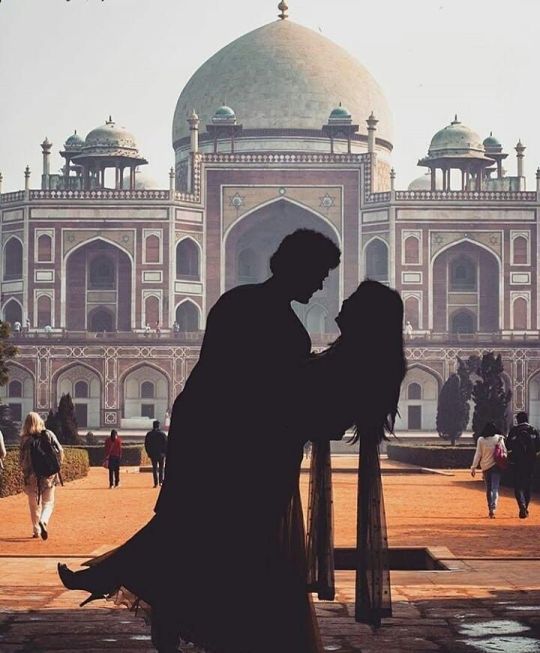
What is Golden Triangle Tour?
It is one among modern India's well-trodden and well-explored paths. The schedule for the Golden Triangle includes trips in Delhi, Agra, and Jaipur. The journey includes famous Indian architectural wonders, Rajasthan sites, and natural wonders. Begin your tour by exploring Delhi. Visit the Jama Masjid, Red Fort, Humayun Tomb, Lodi Garden, and other Mughal-era structures built of red sandstone and marble. Later, go to Agra to witness the Taj Mahal, Agra Fort, Fatehpur Sikri, and other sights. Later, go to the Rajasthan desert region to visit the imperial city of Jaipur, which features palaces, forts, the Jantar Mantar, markets, and much more.
What to do in the Golden Triangle?
So, what's so great about three random locations that form an imagined triangle? On the map, it is simple to select four locations and form a square. Would that make the square more interesting? Not always. Furthermore, the Golden Triangle is not just three random sites that are famous for the form their locations make on a map. What's inside those destinations is what makes the Golden Triangle spectacular.
Delhi - Infusing exquisiteness into Islamic life
Walk through the streets of Old Delhi to enter a virtual time machine and travel back several centuries. The old havelis, market squares, and cobblestone alleys live up to the title "Old." What else can Delhi offer you besides some ancient monuments? Because Delhi is the country's capital, it is connected to nearly all of the country's locations. Within Delhi, you may experience the culture of the entire country, whether it's through performance arts, cuisine, festivals, or shopping.
Agra - The Mughal, Marble, and Marvel Capital
The Taj Mahal, a polished marble mausoleum known for its carvings, structural beauty, and use of semi-precious stones in construction, is the crown gem of all Indian architecture. Once you've finished photographing the Taj Mahal and have filled your memory disc, it's time to move on to other elite Mughal landmarks such as Agra Fort, Baby Taj, Akbar's Tomb, and many more. Fatehpur Sikhri, the abandoned capital city of the Mughal Empire, is another reminder of the Mughal Empire.
Jaipur is a fortified city with hidden temples.
This is a fortified city. Starting at City Palace, you can go on a history walking tour of palaces and forts. The craggy terrain of Aravalli hills with a hint of desert view provides this place a majestic appearance. Immerse yourself in Jaipur's attractions such as Amber Fort, Nahargarh Fort, Shri Jagatshironmani Temple, City Palace, Jantar Mantar, Hawa Mahal, and many more.
#vacation#travel#holiday#india#uk#london#san francisco#taxes#france#tourism#united kingdom#united states
2 notes
·
View notes
Text
"Of course, it’s difficult for a Central European to adjust to Asian conditions, but all these outward things are overridden by the shared idea that all of us here are working for. It is just so lovely to see the Red Flag fly over an imperial palace and a Communist Congress in the throne room developing theses on the advancement of world revolution. Despite the blockade, the Russians are very well informed about political and social conditions in other countries and immediately get the right handle on emerging problems. The Third International has grown immeasurably over the space of a year. Last year, at the first, founding congress, it was a little propaganda group, in which the all-important European states were hardly represented. This time, the congress is an assembly of revolutionary leaders from nearly every country on earth. Here there are no distinctions of nationality or race. English and Indian delegates discuss together the question of their common liberation. A Polish delegate makes a long and enthusiastic speech saluting Soviet Russia’s victory over Poland and enjoining another campaign against his country."
- Hilde Kramer, writing from Moscow to a friend in Berlin in 1920
4 notes
·
View notes
Text
June 3rd- Imperial Palace and Yasukuni Shrine
Today we started off with a bit of a sleepy start. Class was early, and I had gone to bed pretty late the previous night. We took the train to the Imperial Palace, and I really enjoyed the walk there. I can’t believe there were so much land that wasn’t being used in such an important part of the city. The trees were gorgeous, but we couldn’t frolic in the park. We couldn’t see much of the palace because a lot of it isn’t open to the public, but from what we could see, it was gorgeous. We walked to the part where the public was allowed and it was a garden-type area. By this time, the rain had cleared and the sun was out. Raj and Vishnu got some crazy pictures here, and we all just walked around until it was time to head to Yasukuni. I was so hungry and my social battery had died some time ago, so as soon as the group got to Yasukuni, we spent 5 minutes there before finding lunch. Vishnu found an Indian place that so insanely good. We all ate so much, and our tummies hurt so bad on the walk back. I was being so brave. Once we got back to the hotel, I knocked out. I woke up about an hour ago to start the readings for tomorrow because we are going to Shinjuku tonight as a group. Lunch was definitely the highlight of my day, and I hope we have fun tonight!
Academic Reflection-
Today’s reading was on the controversy surrounding the Yasukuni Shrine. Because it is a memorial for all of the soldiers who died in World War 2, it memorializes 14 Class A war criminals. Their names are not in any designated area, and are just spread around the shrine. Even worse, the Prime Minister makes visits there to pay respects to the people who gave their lives fighting for what they believed was right - which I understand - but it still sends a very nationalist and dangerous message to surrounding countries. Before doing this reading, I had no idea that there were different classes of war criminals. As defined by a web article on Yasukuni, a Class A war criminal is someone who has committed “crimes against peace” with the “planning, preparation, initiation, or waging of wars of aggression”. It’s a very broad definition, and Ifeel like that could encompass a lot more than 14 people.
As a political science major, it is only fair that I was super fascinated with the World War 2 museum near-by, but no one wanted to go inside with me. It makes sense because it would be giving money to far-right Japanese propaganda, but I still would love to know the narrative that they chose to commemorate. The reading spoke about the different dimensions of issue that the shrine poses - one at the international level and the other at the national level. The international level is obvious, China and Korea feel like Japan still believes they were right in the Rape of Nanking and the use of comfort women. But the national level is a bit stranger. The Japanese Constitution prohibits the state from engaging in any activities that sponsor a specific religion. Yet, frequent trips are made to Yasukuni every year. The other aspect of this domestic issue is the youth’s newfound nationalist ideology that Japan should be completely independent from America. I understand the need to commemorate fallen soldiers, but there should be an exclusion of those who committed war crimes.





2 notes
·
View notes
Text




Speedway Stout (#238)
👍👍👍👍/5
American Imperial Stout
12% Alcohol
Served from a Tap in “Indian Kebab Palace”, a Local Restaurant Located in Fresno, CA
Brewed by AleSmith Brewing Company
Product of USA 🇺🇸
2 notes
·
View notes
Text
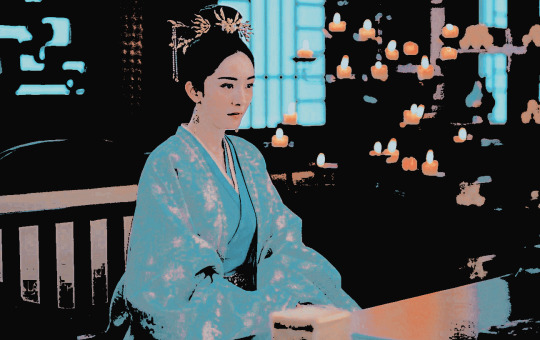
# PEARLNOBLE : an independent original character SHEI YUHAN from gennedy tartakovsky's animated show -- SYM BIONIC TITAN. governed by moe.
𝙸𝙽𝚃𝚁𝙾𝙳𝚄𝙲𝚃𝙸𝙾𝙽. my name is moe (she/her) twenty-three. I am black and cherokee indian. I am undiagnosed with ADHD and so that means that my activity on this blog is medium to low, especially since I have multiple blogs for other canon and original characters.
𝚆𝚁𝙸𝚃𝙸𝙽𝙶 𝚂𝚃𝚈𝙻𝙴. my style of writing will vary throughout my storytelling on this blog but what will remain is the icons and small text. My mutuals are not required to use icons with their replies or even match my choice of text size -- all I ask is to make the replies easy to read and understand.
𝙼𝙰𝚃𝚄𝚁𝙴 𝙲𝙾𝙽𝚃𝙴𝙽𝚃. this blog will feature dark and triggering content not suitable for the easily triggered. The following content goes as said: death, parental death, murder, political corruption, espionage, child death, pregnancy / childbirth / miscarriage, genocide, massacres, blackmail, numerous war crimes, etc. Everything will be tagged accordingly.
𝙵𝙾𝙻𝙻𝙾𝚆𝙸𝙽𝙶. I don't always follow everyone back, it's absolutely nothing personal. I just don't see how our muses could interact. If you want to plot with me please come with an idea of some kind -- otherwise I won't be interested.
𝚄𝙽𝙵𝙾𝙻𝙻𝙾𝚆𝙸𝙽𝙶. I usually soft block if I don't want to follow someone anymore or they make me uncomfortable. The same is applied for me, block me if I make you uncomfortable or you don't have an interest in following me anymore, there won't be any hard feelings.
COMMUNICATION. That being said however, I am a strong advocate for communicating with my partners. You need to tell me upfront if I've done something that made you uncomfortable. Otherwise, I won't know and therefore can't correct myself or maturely address the issue.


Before she became the imperial wife of Emperor Shang, Shei Yuhan started out as a war orphan stricken by poverty like many others. Taken in from the cold and harsh elements of the planet Ethora, Shei underwent intense training in the art of being an assassin a female teacher that would later be revealed to be the Late Empress Yan Qhe -- the mother of her future husband, Shang Qhe.


From palace servant to an imperial guard, a tenacious and quick witted Shei grew close to Prince Shang during the years they spent together and gained a praised favor from his father, Grand Emperor Don Xhao who trusted her enough spy between his imperial wives for any ulterior motives and scheming out of concern for the safety of his son. Ethora and Galaluna secured an alliance between their respective planets and their military. Prince Shang has known Princess Ilana since they were young children and he has a great deal of respect to the princess.
coming soon.


Coming soon.
2 notes
·
View notes
Text
Events 4.10
428 – Nestorius becomes the Patriarch of Constantinople.
837 – Halley's Comet makes its closest approach to Earth at a distance equal to 0.0342 AU (5.1 million kilometres/3.2 million miles).
1407 – Deshin Shekpa, 5th Karmapa Lama visits the Ming dynasty capital at Nanjing and is awarded the title "Great Treasure Prince of Dharma".
1500 – Ludovico Sforza is captured by Swiss troops at Novara and is handed over to the French.
1545 – The settlement of Villa Imperial de Carlos V (now the city of Potosí) in Bolivia is founded after the discovery of huge silver deposits in the area.
1606 – The Virginia Company of London is established by royal charter by James I of England with the purpose of establishing colonial settlements in North America.
1710 – The Statute of Anne, the first law regulating copyright, comes into force in Great Britain.
1717 – Robert Walpole resigns from the British government, commencing the Whig Split which lasts until 1720.
1741 – War of the Austrian Succession: Prussia gains control of Silesia at the Battle of Mollwitz.
1809 – Napoleonic Wars: The War of the Fifth Coalition begins when forces of the Austrian Empire invade Bavaria.
1815 – The Mount Tambora volcano begins a three-month-long eruption, lasting until July 15. The eruption ultimately kills 71,000 people and affects Earth's climate for the next two years.
1816 – The Federal government of the United States approves the creation of the Second Bank of the United States.
1821 – Patriarch Gregory V of Constantinople is hanged by the Ottoman government from the main gate of the Patriarchate and his body is thrown into the Bosphorus.
1821 – Greek War of Independence: the island of Psara joins the Greek struggle for independence.
1826 – The 10,500 inhabitants of the Greek town of Missolonghi begin leaving the town after a year's siege by Turkish forces. Very few of them survive.
1858 – After the original Big Ben, a 14.5 tonnes (32,000 lb) bell for the Palace of Westminster, had cracked during testing, it is recast into the current 13.76 tonnes (30,300 lb) bell by Whitechapel Bell Foundry.
1864 – Archduke Maximilian of Habsburg is proclaimed emperor of Mexico during the French intervention in Mexico.
1865 – American Civil War: A day after his surrender to Union forces, Confederate General Robert E. Lee addresses his troops for the last time.
1866 – The American Society for the Prevention of Cruelty to Animals (ASPCA) is founded in New York City by Henry Bergh.
1868 – At Arogee in Abyssinia, British and Indian forces defeat an army of Emperor Tewodros II. While 700 Ethiopians are killed and many more injured, only two British/Indian troops die.
1872 – The first Arbor Day is celebrated in Nebraska.
1875 – India: Arya Samaj is founded in Mumbai by Swami Dayananda Saraswati to propagate his goal of social reform.
1887 – On Easter Sunday, Pope Leo XIII authorizes the establishment of the Catholic University of America.
1896 – 1896 Summer Olympics: The Olympic marathon is run ending with the victory of Greek athlete Spyridon Louis.
1900 – British suffer a sharp defeat by the Boers south of Brandfort. 600 British troops are killed and wounded and 800 taken prisoner.
1912 – RMS Titanic sets sail from Southampton, England on her maiden and only voyage.
1916 – The Professional Golfers' Association of America (PGA) is created in New York City.
1919 – Mexican Revolution leader Emiliano Zapata is ambushed and shot dead by government forces in Morelos.
1919 – The Third Regional Congress of Peasants, Workers and Insurgents is held by the Makhnovshchina at Huliaipole.
1925 – The Great Gatsby by F. Scott Fitzgerald is first published in New York City, by Charles Scribner's Sons.
1938 – The 1938 German parliamentary election and referendum seeks approval for a single list of Nazi candidates and the recent annexation of Austria.
1939 – Alcoholics Anonymous, A.A.'s "Big Book", is first published.
1941 – World War II: The Axis powers establish the Independent State of Croatia.
1944 – Rudolf Vrba and Alfréd Wetzler escape from Birkenau death camp.
1963 – One hundred twenty-nine American sailors die when the submarine USS Thresher sinks at sea.
1968 – The TEV Wahine, a New Zealand ferry sinks in Wellington harbour due to a fierce storm – the strongest winds ever in Wellington. Out of the 734 people on board, fifty-three died.
1970 – Paul McCartney announces that he is leaving The Beatles for personal and professional reasons.
1971 – Ping-pong diplomacy: In an attempt to thaw relations with the United States, China hosts the U.S. table tennis team for a week-long visit.
1972 – Tombs containing bamboo slips, among them Sun Tzu's Art of War and Sun Bin's lost military treatise, are accidentally discovered by construction workers in Shandong.
1972 – Vietnam War: For the first time since November 1967, American B-52 bombers reportedly begin bombing North Vietnam.
1973 – Invicta International Airlines Flight 435 crashes in a snowstorm on approach to Basel, Switzerland, killing 108 people.
1979 – Red River Valley tornado outbreak: A tornado lands in Wichita Falls, Texas killing 42 people.
1988 – The Ojhri Camp explosion kills or injures more than 1,000 people in Rawalpindi and Islamabad, Pakistan.
1991 – Italian ferry MS Moby Prince collides with an oil tanker in dense fog off Livorno, Italy, killing 140.
1991 – A rare tropical storm develops in the South Atlantic Ocean near Angola; the first to be documented by satellites.
1998 – The Good Friday Agreement is signed in Northern Ireland.
2009 – President of Fiji Ratu Josefa Iloilo announces the abrogation of the constitution and assumes all governance in the country, creating a constitutional crisis.
2010 – Polish Air Force Tu-154M crashes near Smolensk, Russia, killing 96 people, including Polish President Lech Kaczyński, his wife, and dozens of other senior officials and dignitaries.
2016 – The Paravur temple accident in which a devastating fire caused by the explosion of firecrackers stored for Vishu, kills more than one hundred people out of the thousands gathered for seventh day of Bhadrakali worship.
2016 – An earthquake of 6.6 magnitude strikes 39 km west-southwest of Ashkasham, shakes up India, Afghanistan, Tajikistan, Srinagar and Pakistan.
2019 – Scientists from the Event Horizon Telescope project announce the first ever image of a black hole, which was located in the centre of the M87 galaxy.
1 note
·
View note
Text
Edit with the Docs app
Make tweaks, leave comments, and share with others to edit at the same time.
NO THANKSUSE THE APP
''Media Evolution and the Changing World: Its Implication to Communication and Education"

Firstly on the grounds that the civilizations from papyrus and cave paintings of ancient hieroglyphics the chinese gazzete called it palace reports to transfer imperial bulletin or kinetophone in the 19th century telegraph use to transmit and receive signals even writing clay tablets in mesopotamia during bronze and iron age.
Got here together, conversation has been a staple of society for plenty one of a kind purposes. Communication was essential to alternate messages, specific
needs, build relationships,
and negotiate conflicts. Mass
conversation has usually been essential to each tell and enlighten, and has taken many
one of a kind forms as generation has advanced.
Languages people
have a tendency to apply to specific
their experiences. However,
every language is uniquely adapted
to specific simplest certain
elements of our enjoy and much less effectively
at describing different elements. And can’t fully describe a painting with phrases or describe emotions
with numbers. And due to the fact experiences range so much from one culture to another, we cannot fully specific the ideas and
nuances of one culture
in the languages of another.
The Ohlone Indians of the western
United States, who had a strong populace for 5,000 years before
the arrival of the Spanish, had
no phrase for "famine", presumably
due to the fact they had in no way experienced
this type of condition. In furthermore refine the perception of the
language, we
call symbolic a language that
represents records abstractly, outside
of its instant context. For
example, whether or not we're counting, measuring, writing, comparing, or describing anything on this moment. .
This terms "It's shaped like a 5" and "It lasts five days" are simplest distantly related.
The truth there may be no denying this as social networking and
social media have discovered their manner
into our lives , everything is
one of a kind. Starting with
the manner we socialise, interact, plan parties
or maybe how frequently we move out. We will
now no longer have interaction in a debate about
the moral elements of the manner in which Social Networks

affect our lives. Instead, this article indicates focusing at the many methods social media is changing the manner the education
machine works.
Stay tuned to find
out the impact social media is having at the manner our
youngsters are raised, each in and out of school.
Empowerment Effects
Elementary
school via college, social media plays the role of empowering parents, college students, and instructors to explore new methods of sharing records and build
a community. Statistics display that 96% of college students with net access use at the least one social network like blogs
. Even greater notable is that
although a number of the scholars use social media for entertainment and different
purposes, many of
them use it to inspire many effective and
beneficial activities. From locating a summer
internship, selling a success story, winning the conflict towards pupil loans or collaborating on
worldwide projects, anything is
possible.
This is crucial to remember, though, that now no longer all media
are created equal. While a few styles of mass conversation are higher perfect to
entertainment, others make extra feel as a venue for spreading statistics. In
phrases of print media, books are long lasting and capable of include plenty of
statistics, however are distinctly sluggish and highly-priced to produce; in contrast,
newspapers are relatively less expensive and faster to create, making them a
higher medium for the short turnover of each day news. Television affords vastly
extra visible statistics than radio and is extra dynamic than a static printed
page; it could additionally be used to broadcast stay occasions to a national audience, as
in the annual State of the Union deal with given via way of means of the U.S. president. However,
It's also a one-manner medium—that is, it permits for little or no direct
man or woman-to-man or woman conversation. In contrast, the Internet encourages public
dialogue of problems and permits almost everybody who wishes a voice to have one.
However, the Internet is likewise in large part unmoderated. Users can also additionally should wade
via lots of inane remarks or misinformed beginner critiques to find
excellent statistics.
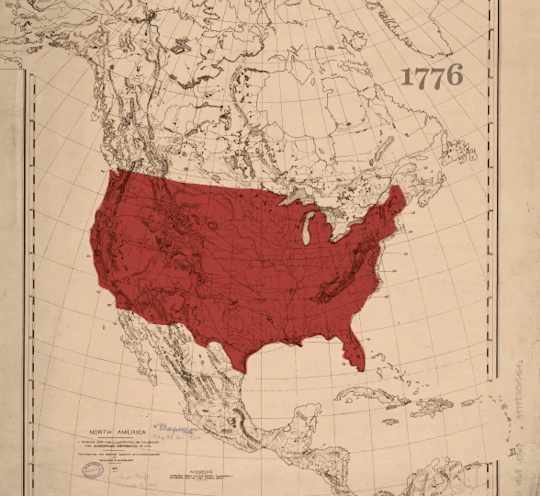
Control representative in 1969 Peter Drucker anticipated that the following predominant technological innovation could be an digital equipment that might revolutionise the manner human beings lived simply as very well as Thomas Edison’s mild bulb had. This equipment could promote for much less than a television set and be “able to being plugged in anyplace there may be strength and giving instant get entry to to all of the records wanted for faculty paintings from first grade thru college.” Although Drucker may also have underestimated the price of this hypothetical machine, he became prescient approximately the impact those machines—non-public computers—and the Internet could have on education, social relationships, and the way of life at large. The innovations of random get entry to memory (RAM) chips and microprocessors in the Seventies have been critical steps to the Internet age. As Briggs and Burke note, those advances intended that “loads of heaps of additives can be carried on a microprocessor.” The discount of many one of a kind sorts of content material to digitally saved records intended that “print, film, recording, radio and television and all kinds of telecommunications [were] now being notion of more and more more as a part of one complex.” This process, additionally referred to as convergence, is a pressure that’s affecting media today.
References
https://csic.georgetown.edu/magazine/social-media-reshaping-todays-education-system/
https://www.googleadservices.com/pagead/aclk?sa=L&ai=DChcSEwiI-pLJksP6AhWTq5YKHSXjDKwYABAAGgJ0bA&ohost=www.google.co.uk&cid=CAASJORo8weSbiHjb7oSnsorj_mlgxosvk6b7uqmx7eUXcVg3xi5Ng&sig=AOD64_02QaL9dxqxUhf359d4_cNYSyyztA&q&adurl&ved=2ahUKEwi-nI3JksP6AhWYAd4KHaPyCNgQ0Qx6BAgDEAE
https://open.lib.umn.edu/mediaandculture/chapter/1-3-the-evolution-of-media/
https://www.scribd.com/slideshare
#mediaandinformationLiteracy2022
6 notes
·
View notes
Text
Suzaku (The Vermilion Bird)
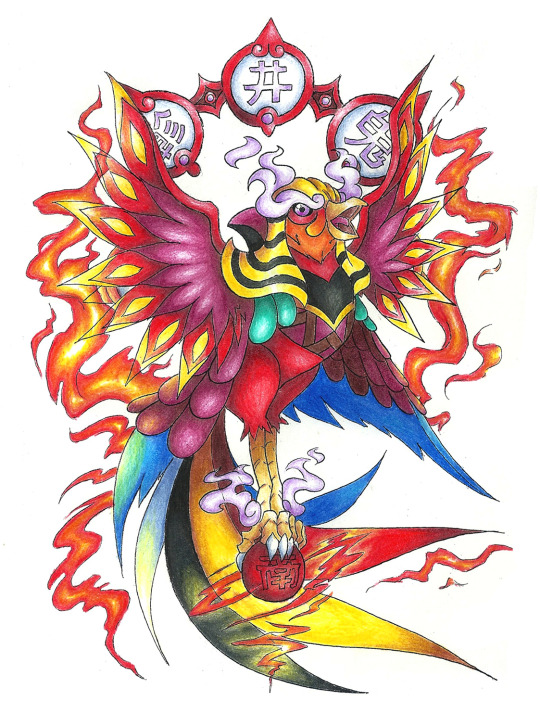
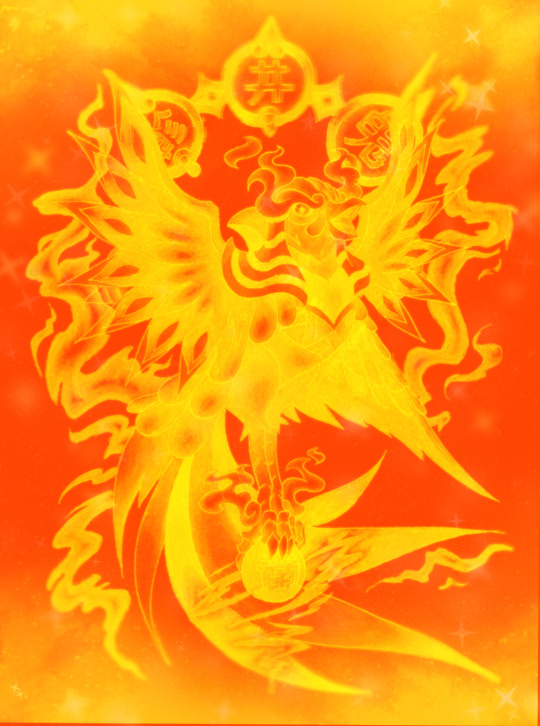
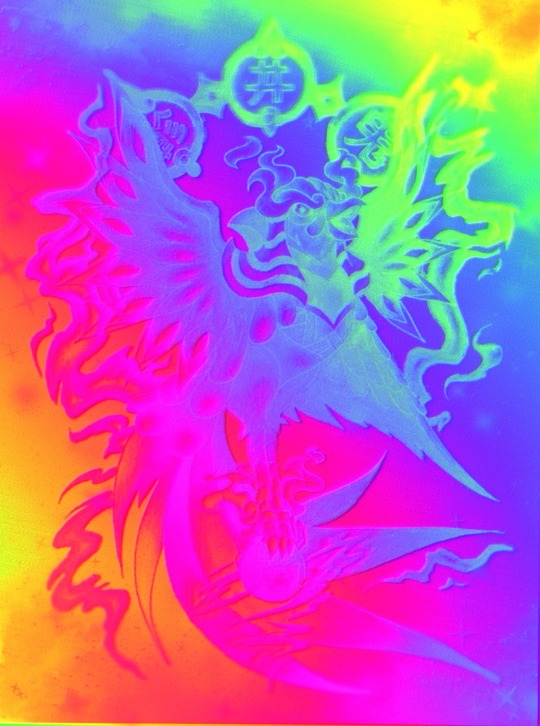
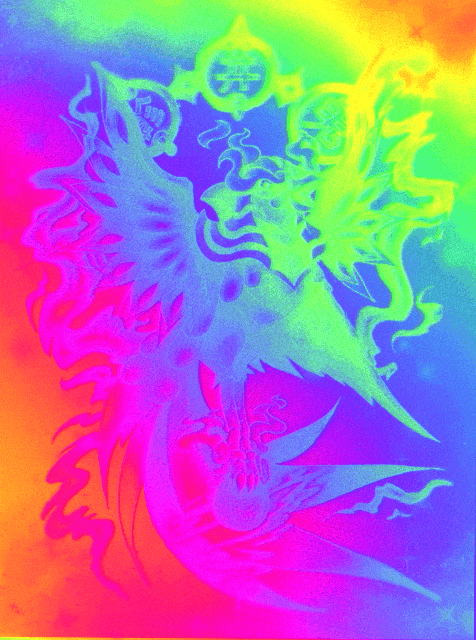
Suzaku (The Vermilion Bird)
Description
Suzaku is a large, scarlet, phoenix-like bird. His home is in the southern sky. He spans seven of the twenty-eight Chinese constellations, taking up one quarter of the entire sky. The constellation which makes up the left wing of the bird is located in Gemini. The constellation which makes up his head feathers or comb is located in Cancer. The constellations which make up his head, beak, and body are located in Hydra. The constellation which makes up his right wing is located in Hydra and Crater. The constellation which makes up his tail feathers is located in Corvus.
Suzaku is one of the shijin, or Four Symbols, which are important mythological figures in Taoism. Suzaku is the guardian of the south. He is associated with the Chinese element of fire, the season of summer, the planet Mars, and the color red. He represents the virtue of propriety. He controls heat and flame. The ancient capitals of Fujiwara-kyō, Heijo-kyō and Heian-kyō were each guarded on the south by a large gate called Suzakumon (Suzaku Gate). Beyond Suzakumon was a wide avenue called Suzaku Boulevard, which served as the main north-south road. In Kyoto, this road ran from the Imperial Palace to the gate at the southern end of the city, Rashōmon. Today, though the gates are long gone, Suzaku Boulevard (now called Senbon Avenue) remains an important road in the city.
Suzaku and the other shijin were brought to Japan from China in the 7th century CE. They are strongly associated with Taoism, feng shui, astrology, the five element theory, and other forms of Chinese mysticism. Japan’s ancient capitals were built in correspondence to these beliefs, with each of the quadrants of the city dedicated to one of the Four Symbols. Excavations of ancient burial mounds in Nara has revealed paintings of Suzaku and the other shijin on the tomb walls.
In later centuries, belief in astrology waned, and worship of the Four Symbols was gradually supplanted by worship of the Four Heavenly Kings of Buddhism. Their use as symbols, however, continued.
Because they look very similar, Suzaku is often confused with hōō, the Chinese phoenix. The attributes and symbolism of one are sometimes mixed or swapped with each other. Though it has been suggested that they may share a common origin—perhaps going back to the mythical bird Garuda in Indian mythology—there is no strong evidence linking these creatures to each other.
Original art / Original image before it became trippy
AtmaFlare At DeviantArt
PS: Btw it really sucks that tumblr doesn’t let people upload gifs with less than 10mb, makes us optimize our gifs and even then it optimizes them even further in theyr servers to 3mb i believe
#chinese#japanese#mythology#folklore#ancient#creatures#suzaku#vermilion#bird#avian#phoenix#cancer#gemini#hydra#symbols#taoism#figures#budhism#heavenly#indian#garuda#fengshui#astrology#elements#constellations#fantasy#artist#photomanipulation#surrealism#trippy
2 notes
·
View notes